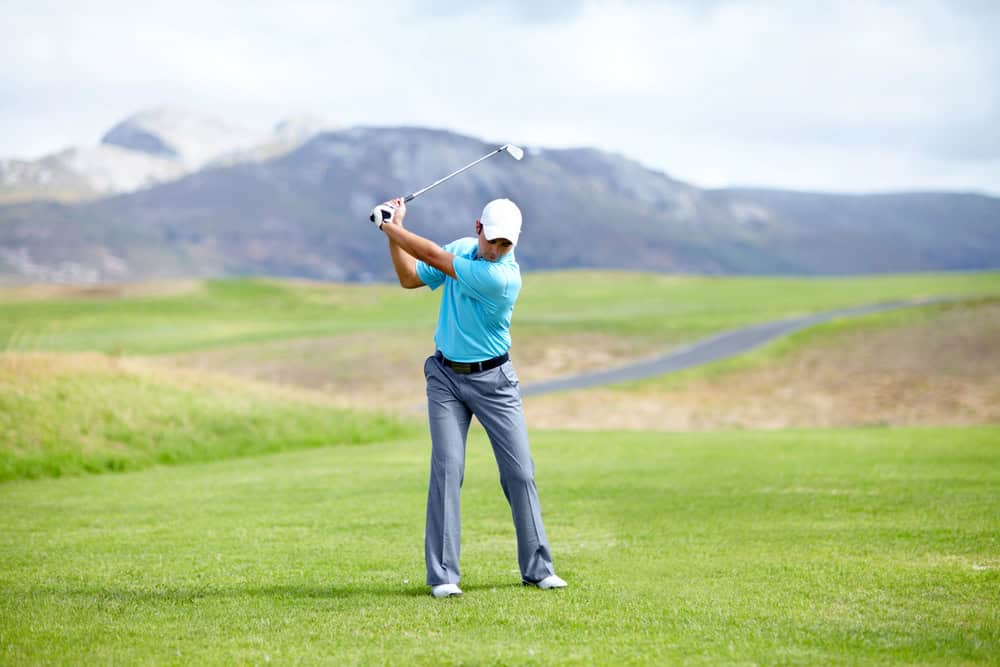
Learning to differentiate between the movements of the hips and the shoulders during the golf swing offers older golfers a direct path to significantly improved performance. Many seasoned players recognize the persistent challenge of losing power and consistency, which often stems from misunderstanding or improperly executing the rotational patterns in the swing. Discover the important role of the golf hip turn vs. shoulder turn because the body’s sequential movement directly translates into effective shots and greater enjoyment on the course. Serious golfers know that achieving the correct biomechanics remains necessary for maximizing clubhead speed and maintaining accuracy, especially when seeking to play more frequently and consistently.
Hip Turn vs Shoulder Turn in Golf
The hip turn vs. shoulder turn represent distinct rotational movements that begin in the backswing and continue through impact, working together for a powerful result. Golfers must start the swing by turning the shoulders away from the target, creating the necessary coil and potential energy that will release into the ball. This initial movement establishes a wider arc, which increases the speed of the club head and helps to regain that lost distance off the tee.
The hip turn, which really starts the downswing, involves the lower body rotating first, pulling the torso and arms into the hitting zone with tremendous force and precision. This lower-body action generates significant power and acts as the engine of the swing, which older golfers require to hit longer, straighter shots routinely. Effective coordination of these two body movements produces a sequence that allows for maximum energy transfer from the body through the club and into the golf ball.
Flexibility Required for Hip Turn and Shoulder Turn
Achieving a full and unrestricted shoulder and hip turn in a golf swing demands specific levels of flexibility throughout the torso and the lower body joints. Limited flexibility, a common issue for golfers aged 60 and older, directly restricts the range of motion for both the hips and the shoulders, reducing power and swing speed. Older players require targeted exercises to improve the rotation in the thoracic spine and the stability in the hips for a better chance at consistency.
Focusing on hip mobility exercises helps players make the necessary space for a powerful downswing, effectively delaying the release of the club for greater impact force. Improving shoulder flexibility allows for a fuller, coil-like backswing, which naturally extends the swing arc for increased distance and control over the clubface. Maintaining or improving the flexibility in both areas remains vital for any golfer serious about reducing aches and pains while sustaining a high level of play.
Impact of Hip Turn on Swing Power
A dynamic and correctly sequenced hip turn supplies the foundational force that directly translates into greater swing power, significantly helping older golfers with their distance. The powerful rotation of the hips in the downswing establishes a proper sequence, allowing the torso and arms to follow naturally and quickly through the impact zone. This lower-body rotation builds a tremendous amount of speed, which transfers directly to the club head, offering players the ability to hit the ball much farther.
Creating a forceful hip turn vs. shoulder turn difference through impact generates the rotational speed needed to compress the golf ball effectively, maximizing the rebound effect. Proper hip rotation prevents the arms and shoulders from dominating the swing, which commonly results in a significant loss of power and accuracy for senior players. Golfers focus on using the strong leg and hip muscles because these large muscle groups deliver the greatest amount of speed to the swing consistently.
How Shoulder Turn Affects Accuracy
The quality of the shoulder turn strongly influences the accuracy and directional control of the golf shot by establishing the correct swing plane during the backswing. A full and centered shoulder rotation keeps the club on the proper path, which dramatically increases the likelihood of a square clubface at the moment of impact. Maintaining the spine angle through the shoulder turn prevents swaying or lateral movement, a common swing fault that leads to inconsistent contact and poor results.
A good shoulder and hip turn in a golf swing make the necessary width and depth in the backswing, making it possible for the golfer to drop the club into the ideal slot on the downswing for consistent striking. The shoulders dictate the arc of the swing, and a correct turn ensures the clubhead approaches the ball from the inside, promoting a powerful and accurate draw. Older golfers prioritize a controlled shoulder turn because this movement offers the reliable foundation for repeatable and predictable shots.
Timing Differences Between Hip and Shoulder Turns
The precise timing of the hip turn vs. shoulder turn offers the most important element for maximizing power and achieving shot consistency for all serious golfers. The shoulder turn starts the backswing, coiling the upper body against the resistance of the stable lower body. This establishes the powerful stretch needed for the transition. This deliberate separation between the upper and lower body creates a ‘lag’ that effectively stores energy until the start of the downswing.
The hip turn starts the downswing, firing the lower body first and pulling the shoulders and arms along, delivering the accumulated power through the impact zone just moments later. This sequential rotation, often called the kinematic sequence, acts as a whip, translating the body’s rotation into massive clubhead speed for extra yardage. Golfers improve their striking consistency by seeing that the hips start turning before the shoulders, using the lower body as the proper driver of the swing.
Shoulder Turn’s Influence on Swing Path
The depth and direction of the shoulder turn directly influence the club’s swing path, determining whether the golfer hits a pull, push, fade, or draw on a regular basis. A correct and full shoulder turn ensures the club stays on the proper plane during the backswing, giving a clear route for the clubhead to return to the ball from the inside on the downswing. Players who restrict their shoulder turn often lift their arms, leading to a steep, outside-in swing path which causes slices and pulls consistently.
Using a full shoulder and hip turn in a golf swing allows the golfer to keep the club more behind the body during the takeaway, establishing a desirable shallower angle of attack. The rotation of the shoulders works with the spine angle to maintain the correct tilt, making sure the clubhead approaches the ball squarely without manipulating the hands. Older golfers must focus on a complete shoulder turn because this action naturally guides the club into the correct hitting position every time.
Achieve Elite Golf Swing Training
You work hard to maintain your competitive edge and want to play your best golf for years to come because the game you love demands the very best from you. We at Berman Golf believe your body’s unique movement, your biomechanics, truly govern your golf swing, not just some generic golf philosophy or single technique. Our proprietary Berman Method of Golf Performance show golfers exactly how to move their bodies with greater efficiency and precision, making significantly more power and much-needed club head speed.
Our instruction offers the ultimate golf swing training, unlike any other lesson or workshop you have ever seen or experienced as we target the specific physical limitations hindering your game. We hold top-tier TPI Certifications and PGA of America credentials, which give the knowledge, experience, and ability you require to regain your distance and shot consistency. We offer luxury, high-end, in-house, and online golf programs and lessons to help golfers aged 60+ play more frequently and confidently. Berman Golf give you the complete trust and confidence you deserve in your pursuit of superior golf. Contact us today to start your journey to better golf.

Dr. Jake Berman

Latest posts by Dr. Jake Berman (see all)
- Why Is My Golf Swing So Inconsistent? Causes And Fixes - November 15, 2025
- How Far Down Should You Grip The Golf Club? A Grip Guide - November 10, 2025
- Driver Vs. Irons: Golf Swing Differences Explained - November 5, 2025

